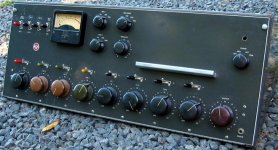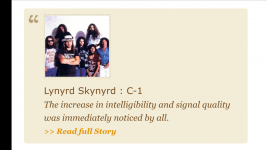As I have said, complex music is muddled (to me) with op-amps ( defined as differential input , extreme open loop gain , feedback global and/or multi-path).
Replay same track under identical conditions - more correct , pleasing and accurate using only local feedback.
I thought possibly the right valve in front could fix it (maybe)
Why don't you fix it for yourself and be done with it? Why do you care if someone is happy with an op-amp phono?
jfetter it is refreshing that someone else can hear the difference between typical IC's and discrete tube or bipolar electronics. I design both, and for the majority, a good IC op amp is adequate. Partially because of the pre-processing of the music, but this is not always so. Some audio sources, especially vinyl can be essentially free of IC op amp processing, and that is what I use for serious evaluation of audio equipment. The rest of the time, one just has to live with what they are given by: CD, TV or FM sources.
It is amazing how some people will pay $100 or more per bottle of quality wine, at least for special occasions, yet ignore that someone somewhere will insist that they are wasting their money due to some double-blind test, that has implied that this is so. Yet, the serious listeners are told to not waste their time, money, and effort on quality audio electronics, by the same people. '-)
It is amazing how some people will pay $100 or more per bottle of quality wine, at least for special occasions, yet ignore that someone somewhere will insist that they are wasting their money due to some double-blind test, that has implied that this is so. Yet, the serious listeners are told to not waste their time, money, and effort on quality audio electronics, by the same people. '-)
Bs. How did vinyl miss opamps when 98% of recording equipment run the audio thru multiple opamps.
I thought possibly the right valve in front could fix it (maybe)
How would that work, with the tube in front of the opamps? Wouldn't the opamps after the tube again muddle the sound, or does the tube 'pre-unmuddle' it?
Can't make any sense of this, but maybe I read this wrong?
Jan
Yet, the serious listeners are told to not waste their time, money, and effort on quality audio electronics, by the same people. '-)
Well no one would grumble if someone decided that 10k spent on a pair of Kii3 was a good purchase. That is well engineered quality audio electronics. However 10k on a cable, or some flooby products is a waste of time from the audio quality perspective. Pride of ownership or general going one better is as ever, entirely personal and a preference thing.
I'm not convinced that the Kii3 is a good speaker.
There may be an opportunity to listen to some, and if it happens, I'll let you know.
Still don't know how that speaker eliminates floor bounce though... but at that p[rice point it had best sound very very good. Would be pleased to be impressed.
There may be an opportunity to listen to some, and if it happens, I'll let you know.
Still don't know how that speaker eliminates floor bounce though... but at that p[rice point it had best sound very very good. Would be pleased to be impressed.
How would that work, with the tube in front of the opamps? Wouldn't the opamps after the tube again muddle the sound, or does the tube 'pre-unmuddle' it?
Can't make any sense of this, but maybe I read this wrong?
Jan
Best I can take is that he likes having some tube electronics in-circuit *somewhere*. I.e. makes him happy. (And pretty much harmless)
Bs. How did vinyl miss opamps when 98% of recording equipment run the audio thru multiple opamps.
A very good question.
Two possibilities. Both can be present at the same time.
First, many albums were made entirely on tube equipment.
Most albums likely were cut on lathes running tubes to the cutter heads.
(the entire Rudy Van Gelder Blue Note catalog, for example - holds up great today, right?)
Some of course were made on lathes using solid state amps...
Another note is that probably a majority of albums cut originally for LP were made with tube gear, and then discrete opamp based gear. Neve being the biggest name out of many.
Second, there well may be an "integrating" effect due to the physical nature of cutting and the pressing. This well may produce a waveform that differs from the equivalent processing applied to a digital format in terms of harmonic content, but still conforms closely to the "original signal" that came off the microphone itself. --this makes the most sense when considering a minimalist two microphone recording, of course --
Then too the effect of using a phono cartridge should not be ignored either. So in effect there are two "un-opamp" filter passes with vinyl.
You might argue that this is a form of euphonia, or the addition of "distortion". But one could also argue that this is in conceptual terms more like what one would perhaps want to do to a digital signal in DSP to "predistort" in order to reduce undesirable artifacts?
What do you think?
Last edited:
So the dozens of opamps the music went thru before you got it didn't "muddle" the sound, just the last one you use?
Yes true , that contributes to many music sales failures.
Im traveling right now so can't do the search for you but dowload some tapeop back issues then Google - valve mixers etc.
Then try to buy a tube mixer , compressor or tube mike.
They are in high demand.
Read Tape Op #115 | Tape Op Magazine | Longform candid interviews with music producers and audio engineers covering mixing, mastering, recording and music production.
The mothballed consoles have been put back to work too.
Here is just one interesting mixer project.
https://drive.google.com/drive/mobi...UGNpU3gzdWJXa1g5T3JpbXhSN2hXdTg?usp=drive_web
-
Attachments
JFetter, this is besides the point.
Objectively these consoles and circuits measure worse than their solid state opamp based counterparts. So, the engineer/scientist types who take the viewpoint "if it measures better, it is better" will disagree and point out the usual reasons why...
Sounding euphonic and pleasing != "more accurate".
(or is it?)
Objectively these consoles and circuits measure worse than their solid state opamp based counterparts. So, the engineer/scientist types who take the viewpoint "if it measures better, it is better" will disagree and point out the usual reasons why...
Sounding euphonic and pleasing != "more accurate".
(or is it?)
Why the attempts to foment, Bear? Why the nonsensical arguments and projections. The few comments that fall in the line of "it measures better" are followed/preceded by something of the form, "I prefer knowing that I'm getting exactly what's on the disc/record" or, "Linear electronics plus messing around in DSP".
The contention around opamp sound has largely surrounded audibility/inaudibility.
Plus no harm, no foul if those old mixers are adding a sound that is designed. They're an instrument, no?
The contention around opamp sound has largely surrounded audibility/inaudibility.
Plus no harm, no foul if those old mixers are adding a sound that is designed. They're an instrument, no?
Sounding euphonic and pleasing != "more accurate".
(or is it?)
Two channel recorded music is a simulacrum so all is fair in the effects that please you, there is no accurate.
SY, how did you count 6 opamps in your experiment? Did you use a counting instrument or did you just eyeball the scene and decided there are about 6 of them?


Why the attempts to foment, Bear? Why the nonsensical arguments and projections. The few comments that fall in the line of "it measures better" are followed/preceded by something of the form, "I prefer knowing that I'm getting exactly what's on the disc/record" or, "Linear electronics plus messing around in DSP".
The contention around opamp sound has largely surrounded audibility/inaudibility.
Plus no harm, no foul if those old mixers are adding a sound that is designed. They're an instrument, no?
Huh?
SY, how did you count 6 opamps in your experiment? Did you use a counting instrument or did you just eyeball the scene and decided there are about 6 of them?

https://www.youtube.com/watch?v=xOrgLj9lOwk
JFetter, this is besides the point.
Objectively these consoles and circuits measure worse than their solid state opamp based counterparts. So, the engineer/scientist types who take the viewpoint "if it measures better, it is better" will disagree and point out the usual reasons why...
Sounding euphonic and pleasing != "more accurate".
(or is it?)
Lobs out generalities, projects stereotypes, and casts aspersions. Generally we'd call that foment.
Anything pressed from the mid-60's on back won't have IC opamps. The 50's on back is tubes.Bs. How did vinyl miss opamps when 98% of recording equipment run the audio thru multiple opamps.
Not sure how many valve console mfgs today. I spent a few minutes and found quite a few. Some hybrids too.
users: TL Audio Users
Bottom of this link has some sample music.
PRODUCTION | The Sanctuary Studio
Remastering? I can see the advantage. I'm "re-mastering" by simply going through the Sziklai 12au7 hybrid in playback.
Nashville, London, Austin and LA I'm sure lots of studios.
Im sure some studios keep the advantage secret.
Ultimately the $customers$ will decide which labels survive.
I have to focus back on my projects so later.
Bruce
-
users: TL Audio Users
Bottom of this link has some sample music.
PRODUCTION | The Sanctuary Studio
Remastering? I can see the advantage. I'm "re-mastering" by simply going through the Sziklai 12au7 hybrid in playback.
Nashville, London, Austin and LA I'm sure lots of studios.
Im sure some studios keep the advantage secret.
Ultimately the $customers$ will decide which labels survive.
I have to focus back on my projects so later.
Bruce
-
Attachments
You want the purest non-opamp sound available anywhere? Pick up your vintage Martin acoustic guitar and play!! No beaming, overload, T.H.D., S.I.D., T.I.M., settling time issues, phase distortion, cone breakup, cable losses, resistor/capacitor non-linearity, coupling deficiencies, rumble, ripple, sag or anything else in the way!! As pure as it gets!!!
- Status
- Not open for further replies.
- Home
- General Interest
- Everything Else
- What is wrong with op-amps?


